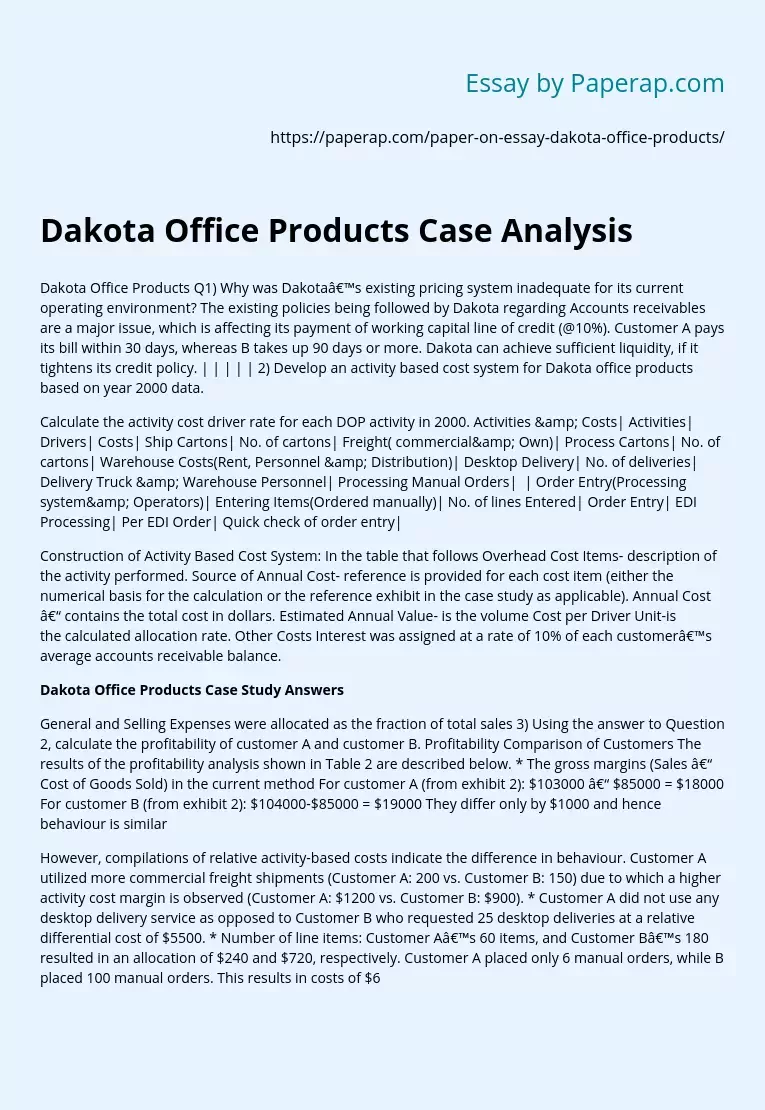Dakota Office Products Case Analysis
Dakota Office Products Q1) Why was Dakota’s existing pricing system inadequate for its current operating environment? The existing policies being followed by Dakota regarding Accounts receivables are a major issue, which is affecting its payment of working capital line of credit (@10%). Customer A pays its bill within 30 days, whereas B takes up 90 days or more. Dakota can achieve sufficient liquidity, if it tightens its credit policy. | | | | | 2) Develop an activity based cost system for Dakota office products based on year 2000 data.
Calculate the activity cost driver rate for each DOP activity in 2000. Activities & Costs| Activities| Drivers| Costs| Ship Cartons| No. of cartons| Freight( commercial& Own)| Process Cartons| No. of cartons| Warehouse Costs(Rent, Personnel & Distribution)| Desktop Delivery| No. of deliveries| Delivery Truck & Warehouse Personnel| Processing Manual Orders| | Order Entry(Processing system& Operators)| Entering Items(Ordered manually)| No. of lines Entered| Order Entry| EDI Processing| Per EDI Order| Quick check of order entry|
Construction of Activity Based Cost System: In the table that follows Overhead Cost Items- description of the activity performed.
Source of Annual Cost- reference is provided for each cost item (either the numerical basis for the calculation or the reference exhibit in the case study as applicable). Annual Cost – contains the total cost in dollars. Estimated Annual Value- is the volume Cost per Driver Unit-is the calculated allocation rate. Other Costs Interest was assigned at a rate of 10% of each customer’s average accounts receivable balance.
Dakota Office Products Case Study Answers
General and Selling Expenses were allocated as the fraction of total sales 3) Using the answer to Question 2, calculate the profitability of customer A and customer B. Profitability Comparison of Customers The results of the profitability analysis shown in Table 2 are described below. * The gross margins (Sales – Cost of Goods Sold) in the current method For customer A (from exhibit 2): $103000 – $85000 = $18000 For customer B (from exhibit 2): $104000-$85000 = $19000 They differ only by $1000 and hence behaviour is similar
However, compilations of relative activity-based costs indicate the difference in behaviour. Customer A utilized more commercial freight shipments (Customer A: 200 vs. Customer B: 150) due to which a higher activity cost margin is observed (Customer A: $1200 vs. Customer B: $900). * Customer A did not use any desktop delivery service as opposed to Customer B who requested 25 desktop deliveries at a relative differential cost of $5500. * Number of line items: Customer A’s 60 items, and Customer B’s 180 resulted in an allocation of $240 and $720, respectively. Customer A placed only 6 manual orders, while B placed 100 manual orders. This results in costs of $60 and $1000 for A and B respectively. * Customer A executed 6 EDI orders at a cost of $30. Customer B did not use the EDI facility. * Each customer warehoused 200 cartons, for an assigned cost of $10,400. * Based on all activity-based costs, contribution margin from Customer A is calculated to be $6,070 and that for Customer B is $480. Thus, here, a huge disparity in profitability of the Customers is observed.
Dakota Office Products Case Analysis. (2019, Dec 05). Retrieved from https://paperap.com/paper-on-essay-dakota-office-products/

